Originally published in the Martinez News-Gazette on March 17, 2019From our last column, we discovered Aaron had siblings. Although his sister Judy Schlesher (58) was never found, (nor could we find any record of her) his older brother William (62) and family, were located living in McKinney, Collin County, Texas. We additionally found them enumerated in the 1880 Census living in the same location but unfortunately have find no other records. How did William’s family end up in Texas separated from Aaron’s? As reported earlier, William (the slave-owner) moved to California in 1859 to avoid prosecution for his involvement in the “Bleeding Kansas” conflict with the additional intent of continuing Aaron’s family enslavement. His siblings probably moved to Texas for the same reasons. Zibbah Rice and her family lived in Grayson County in 1858, while Elihu Coffee Rice, a cattle rancher, moved with his family to Texas in 1861. When General Order No. 11 in 1863 ordered southern sympathizers to evacuate their lands, Elihu stayed until 1866. With Aaron’s niece Lucy born 1864 in Texas, it corroborates either could have been responsible for his brother’s family relocation. When we last left Aaron, he had sold the family farm to Manual Lucas for the necessary monies to file Dilcy’s probate and moved in with his son Nathaniel and new wife Annie residing on Napa’s Main St. From their 1880 and 1881 voter registrations, Aaron continues farming while Nathaniel finds work first as a teamster, then a peddler. Nathaniel and Annie then follow her family to Vallejo where he finds work as a laborer according to his March 16, 1882 registration. 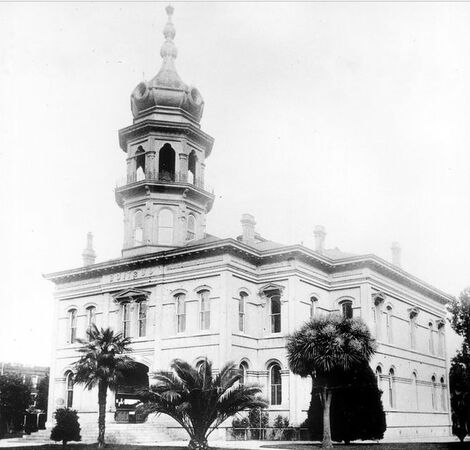 1879 Napa County Courthouse, Napa CA - Courtesy Public Domain 1879 Napa County Courthouse, Napa CA - Courtesy Public Domain According to deeds of sale recorded by the Napa County Recorder’s Office, Nathaniel acquired two parcels (160 acres and 80 acres) of state school land located around Yountville. The State of California’s land office sold property specifically set aside for new schools. Presumably, Nathaniel’s intent was to build an African-American grade school, while serving as its headmaster and one of its school teachers as well. He sold the 80-acre parcel on January 16, 1886, for $5 ($140 today) to a James E. Francis and George Cuthbert. Hoping to accomplish his dream, he held on to the 160-acre parcel for almost two years before finally giving up and selling it to the same buyers for another $5 on October 22, 1887. 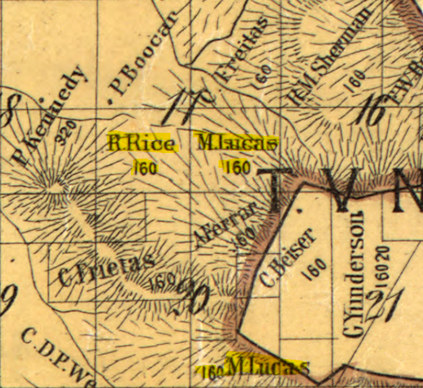 1876 Napa County Map - Courtesy Public Domain 1876 Napa County Map - Courtesy Public Domain Meantime, Aaron (66) moves to Walnut Creek according to his September 15, 1886 voter registration. He continues farming while living on Louisa Rice’s (William’s widow) ranch. With William’s death from heart failure the year before (November 4, 1885), and the promise of payment for his services, Aaron was willing to work again for his previous slave owner’s family. Since Judy was never found, the Napa County Tax Collector seizes her portion of Dilcy’s land for delinquent tax owed to the county. The property is sold at auction on May 1, 1888 for $3 ($85 today) to the same Manual Lucas who previously purchased the rest of the Rice family farm. Nathaniel’s (42) May 31, 1888 voter registration records his and Annie’s return to E Napa as a farmer. Soon after Annie (39) dies on January 11, 1890 from paralysis (stroke), while living in Oakland. Nathaniel finds work there as an expressman after her death. The 1891 Oakland City Directory lists him at 708 4th St, while his September 27, 1892 voter registration records his move to 664 4th Street. Meanwhile, Aaron continues to live and farm on Louisa’s ranch according to his October 19, 1892 voter registration. 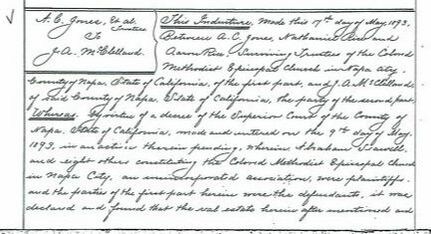 May 9, 1893 Church Deed - Courtesy The Palmers May 9, 1893 Church Deed - Courtesy The Palmers By 1893, the Napa AME Church officially closes. Aaron, Nathaniel, and an A. C. Jones as its surviving trustees\founders sell its property on May 9, for $700 ($19,751 today) to H.H. Briggs. With the last connection to their home gone, Nathaniel continues his wanderlust, finding odd jobs along the way. From his April 8, 1885 voter registration Nathaniel (48) is listed as a minister residing in Hollister, San Benito County. Aaron (75) on the other hand, stays on the Rice Ranch and is now a laborer instead of a farmer, as recorded by his July 8, 1886 voter registration. From the June 1900 Census, Nathaniel (53) is back in Napa lodging with the Canners while working as a day laborer and Aaron (80) is reduced to working as a servant for Louisa (78), who has become quite frail. This Census is our first official record that Aaron is literate despite his physical ailment preventing him from signing. 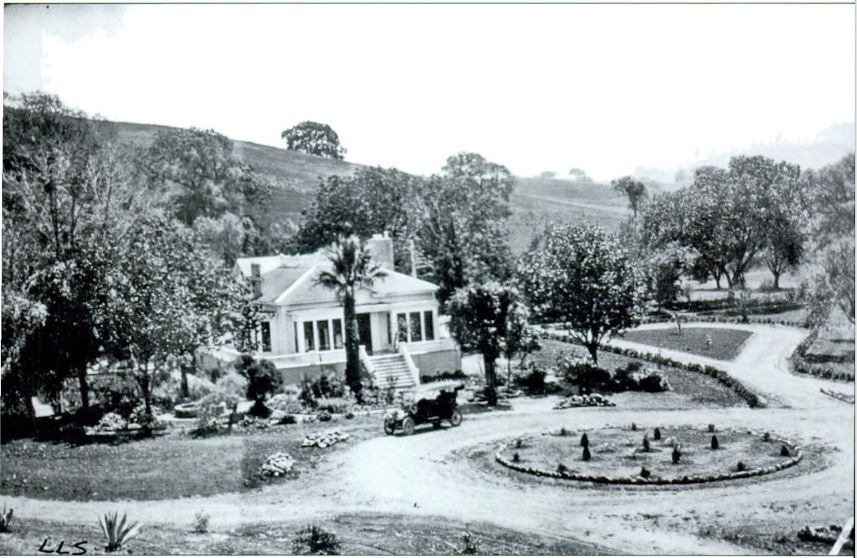 Louisa's Walnut Creek Home Circa 1917 - Courtesy Images of America Walnut Creek Louisa's Walnut Creek Home Circa 1917 - Courtesy Images of America Walnut Creek On February 6, 1904, Louisa (82) passes at home from unknown causes. Not long after Aaron (86), frail and weak, is left anonymously at the Martinez County Hospital, on July 23, 1905. Eight days later, he dies from “old age” on July 31 and finally laid to rest in the County Cemetery’s (now Alhambra Cemetery) Potter’s Field on August 4, as recorded by his official death certificate. 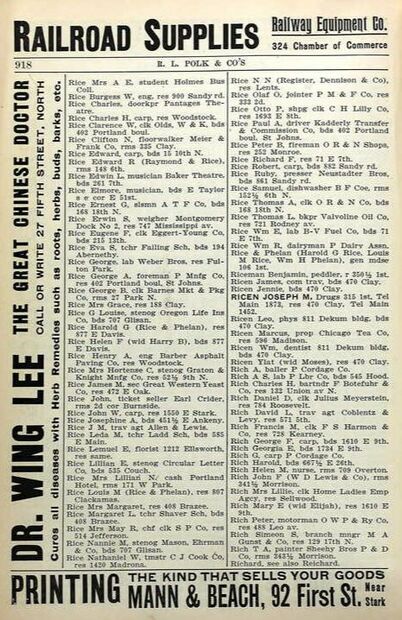 Portland City Directory 1906 - Courtesy Public Domain Portland City Directory 1906 - Courtesy Public Domain Since Nathaniel is not listed as Aaron’s informant, chances are great that he received late notification and missed his father’s burial while living in Portland, Oregon. According to city directories, he is recorded working as a laborer living at 175 E Water Ave in 1905, as a teamster living at 1420 Madrona St in 1906, and finally the same living at 423½ Davis St in 1907. Also from city directories, he then returns to California working as a laborer first living at 1523 C St, Fresno in 1908, then living at 740 Charles St, Santa Rosa in 1909. Next he returns to Oakland as a laborer while living at 805 Harrison St according to his 1910 voter registration and fudges his age listing himself as (54) instead of (64). Two years later he’s an expressman living at 508 Jefferson St, Oakland conferred by his 1912 registration. Nathaniel’s final record was his death certificate from Seattle, King County, Washington. Wanting absolute proof, we ordered a copy that arrived recently. It records his admittance to the local hospital on May 1, 1917 before dying on July 19, from cirrhosis of the liver and dropsy (edema) at the age of 71. Additionally, it listed him living as a border while working as a peddler in Seattle prior to his death. He is buried July 21, in Seattle’s Lakeview Pioneer Cemetery. 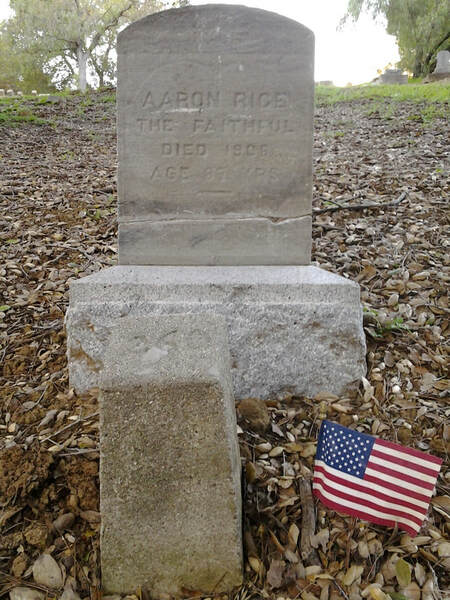 Aaron Rice Repaired Headstone 2019, Courtesy The Palmers Aaron Rice Repaired Headstone 2019, Courtesy The Palmers We started this journey after discovering Aaron’s broken headstone and wanting to know who he was. According to its inscription, he died on July 31, 1906, age 87 with “The Faithful” noted under his name. Why the discrepancy between his headstone and death certificate? Perhaps significant time lapsed from Aaron’s death to his headstone’s arrival. Which brings us back to our original questions. Who paid for his headstone? What does “The Faithful” mean? While we may never know definitively, we suspect a member of Louisa’s family, as slave owners commonly used the phrase in reference to former slaves who remained in their family’s employment. With that, we hope you have enjoyed Aaron Rice and his family’s story as much as we have in its discovery. It’s bittersweet to bring it to its conclusion as they have become family to us. However, as new information comes to light, we will publish updates accordingly. Till then, we have many more stories to share… Judie & Joseph Palmer are two of the founding members of the Martinez Cemetery Preservation Alliance (MCPA) and the Potter’s Field Project. Both have a passion for discovery, history, genealogy, anthropology and archaeology. For more info, please visit our website MartinezCemetery.org. Do you have a Potter’s Field story to tell? We welcome any pictures or information regarding the Alhambra Pioneer Cemetery or its Potter’s Field. Please email us at [email protected] or call us at (925) 316-6069.
Originally published in the Martinez News-Gazette on 02/17/2019.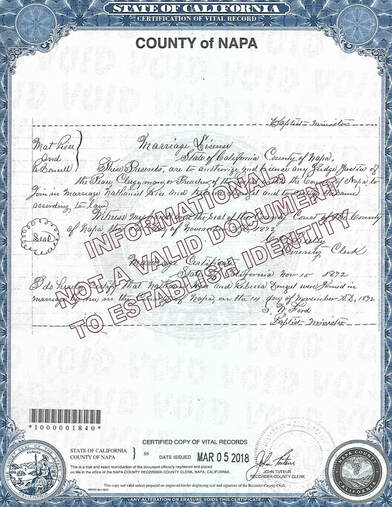 1872 Marriage Certificate Rebbeca, Courtesy the Palmers 1872 Marriage Certificate Rebbeca, Courtesy the Palmers When we last left Aaron and his family, they were living blissfully. They had become in a relative short period: property owners, industrious entrepreneurs, founders of Napa’s AME Church, ardent voters and proud US citizens. As proof of their accomplishments an announcement published in the Napa County Recorder on March 18, 1871, mentions Rev. Robert Rice (Aaron’s father) gave two sermons a day as AME’s acting minister while Nathaniel (Aaron’s son) was the Sunday school’s superintendent. On November 14, 1872, the family grew when Nathaniel married Rebecca Danzel at the Napa Courthouse. They became the 311th couple registered in Napa County when the Baptist minister on hand, Rev. G. W. Ford, joined them in matrimony. The County Clerk acted as their witness as no family members were present. 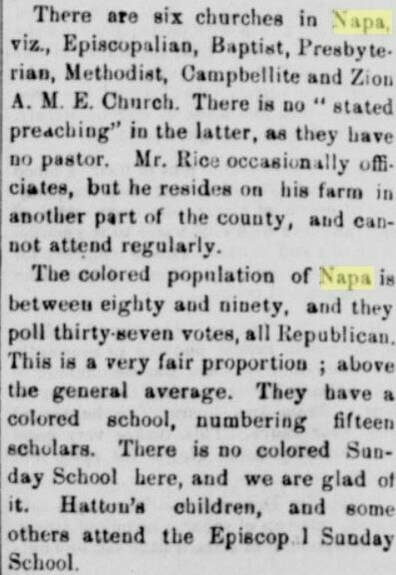 Elevator - November 1, 1873, Courtesy Public Domain Elevator - November 1, 1873, Courtesy Public Domain The Elevator publishes their Napa report on November 1, 1873, “…There are six churches in Napa, viz., Episcopalian, Baptist, Presbyterian, Methodist, Campbellite, and Zion A. M. E. Church. There is no “stated preaching” in the latter, as they have no preacher. Mr. Rice occasionally officiates, but he resides on his farm in another part of the county, and cannot attend regularly. The colored population of Napa is between eighty and ninety, and they pole thirty-seven votes, all Republican. This is a fair proportion; above the general average. They have a colored school, numbering fifteen scholars. There is no colored Sunday School here ….” What caused these major changes to occur in the last two years? The local Episcopal Church had recently integrated their Sunday School which could explain what happened to Nathaniel’s school. By September 25, 1874, Rev. Robert Rice completes the terms of his Homestead 1862 application, giving the family free and clear ownership of their farm. However, he dies soon after on March 20, 1875 from dropsy (edema) age 75. Failing health would have explained his officiating decline. Four days later, Dilcy his wife is awarded his estate worth $164.16 ($3,800 today) after expenses of a $100 bond, court costs and unknown attorney fees. On November 1, Rebecca age 21 dies childless of consumption (tuberculosis). From Tulocay Cemetery’s records, she’s listed as “Copper” (Asian descent). With her Danzel surname, perhaps she had a white parent. “Mixing races” is extremely frowned upon in White Supremacist culture, dominant in California at the time, (this could explain the lack of family attendance at their wedding.) Two and half months later, Dilcy age 84 dies of “old age” on February 16, 1876, followed by Charlotte (Aaron’s wife) age 64 on March 3, from Typhoid Fever. Since Typhoid is a very contagious disease, it’s most likely Dilcy’s cause of death too. In less than a year, Nathaniel and Aaron became their family’s sole survivors.  1877 Marriage Certificate Annie E., Courtesy the Palmers 1877 Marriage Certificate Annie E., Courtesy the Palmers Choosing to not remain a widower long, Nathaniel 31 marries Annie Elizabeth Dyer 27, Edward Hatton’s stepdaughter on October 31, 1877, with the prominent Rev. Richard Wylie, pastor of the Napa Presbyterian Church officiating. This time both families were present and their wedding was witnessed by her stepbrother Joseph Hatton and Fred Sparrow (the first African-American registered to vote in Napa), giving further proof of the friendship between the two families and high esteem the Rice’s were held in. (Interesting side note, their marriage certificate states, “neither party married before.”) Despite their tragic losses, Aaron, Nathaniel, and now Annie managed to keep the farm going. Unfortunately, in order to avoid any penalties, he had to register Dilcy’s probate to resolve her 1\3 ownership portion of the farm before the four-year grace period elapsed. (None is required for Charlotte’s estate because she is not listed on the deed.) Aaron sells his 2/3 interest to Manual Lucas on January 17, 1880 for $500 ($12,500 today) and files the paperwork. Mr. Lucas was a large property owner in Napa County and possibly allowed Aaron to continue working the land as his employee. Nathaniel 33, on the other hand, begins taking odd jobs. His May 3rd voter registration lists him as a teamster along with the US Census taken June 17. Aaron 59 is recorded as a laborer living with Nathaniel as head of household and his wife Annie 28 keeping house. From Nathaniel’s September 14 voter registration, he is now a peddler while Aaron’s October 4th, reveals he’s still a farmer.  Aaron Rice's Signature, February 2, 1880, Courtesy Public Domain Aaron Rice's Signature, February 2, 1880, Courtesy Public Domain Unlike Robert’s estate, Dilcy’s takes eight months to resolve. Over the course of the proceedings, Aaron learns to write as illustrated by his signature’s dramatic improvement. (Although he is still recorded as illiterate by the June Census.) Her probate cost $123.10 ($3,300 today) not including attorney fees with her estate’s estimated worth set at $170 ($4,500 today). 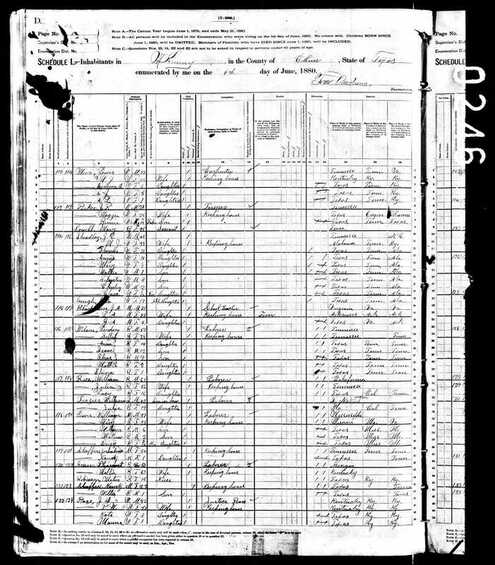 June 4. 1880 US Census, McKinney, Collin County TX, Courtesy Public Domain June 4. 1880 US Census, McKinney, Collin County TX, Courtesy Public Domain On August 17, the final distribution hearing is held revealing the surprising discovery that Aaron had siblings, William Rice 62 and Judy Schlesher 58 - whereabouts unknown. The judge orders each to receive a third of Dilcy’s property once they are located, prompting an immediate hunt to find them. It would take almost three years before William is located in McKinney, Collin County, Texas. He promptly sells his portion to Mr. Lucas for $50 ($1,250 today) on July 14, 1883, with his signature notarized in Collin County, Texas. Unfortunately, Judy was never found causing her portion to be seized by the sheriff for back taxes. It was sold at auction to Mr. Lucas on May 1, 1888. With the discovery of Aaron’s siblings, we wanted to know more. Unfortunately we couldn’t find any record of his sister Judy but were luckily enough to find William and his family recorded by the US Census on June 4, 1880, living in McKinney, Collin County, Texas. It lists William 61 laborer head of household, living with his wife Julia 56 born in Tennessee, oldest daughter Julia 19 born Missouri, married to William Frazier 40 laborer born as Indian Nation Native, and youngest daughter Lucy 16, born in Texas. Most of his family is illiterate, outside of Lucy being able to read and his son in law. Look for the Final Chapter next… Judie & Joseph Palmer are two of the founding members of the Martinez Cemetery Preservation Alliance (MCPA) and the Potter’s Field Project. Both have a passion for discovery, history, genealogy, anthropology and archaeology. For more info, please visit our website MartinezCemetery.org. To learn more regarding our sources and detail about Aaron’s life, type Aaron Rice in the Search Bar. Do you have a Potter’s Field story to tell? We welcome any pictures or information regarding the Alhambra Cemetery’s Potter’s Field. Please email us at [email protected] or call us at (925) 316-6069.
Originally published in the Martinez News-Gazette on 02/17/2019. Holiday Food - Courtesy, The Parent Report Holiday Food - Courtesy, The Parent Report Picking up Aaron’s story from where we left off, William Rice still had custody of Nathaniel while the rest of his family was free. They finally get to celebrate the holidays without following someone else’s rules. This included their first ever Thanksgiving as it was not recognized in the South while Christmas was actually illegal in the North and wasn’t a federal holiday until 1870. When William Russell sells his Napa property to Robert and Charlotte for $100 ($3,000 today) on September 19, 1860, it established the family’s livelihood for years to come. For the Rice family to keep the land, under the Preemption Act of 1841, they had to cultivate crops or build a home. The 1853 U.S. California Survey Act allowed only improved property to be sold or purchased with few exceptions, which makes the Rice family’s acquisition even more impressive. 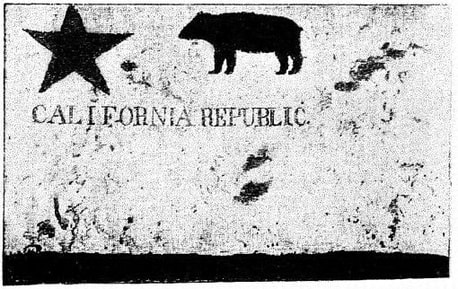 1890 Photo of Original Todd Flag, Courtesy Public Domain 1890 Photo of Original Todd Flag, Courtesy Public Domain With the Civil War fast approaching, they become both observers and participants of one of the most consequential periods of California and US History. President Lincoln’s election on November 6, creates great tension within the state and anxiety for African-Americans. Approximately twenty percent were Southern sympathizers, with large numbers in Monterey, Napa, San Francisco, San Joaquin, Santa Clara and Tulare Counties along with the majority of Southern Californians, who supported and attempted secession. On April 12, 1861, the Civil War officially begins and by September 4, California elects its first Republican Governor, Leland Stanford. The state goes on to bankroll the Union’s cause while remaining unified. 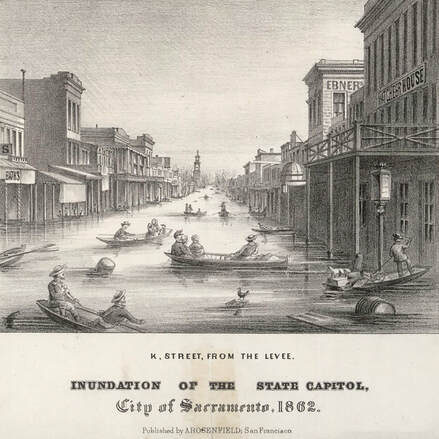 Courtesy Public Domain Courtesy Public Domain The Great Flood of 1862 brings about enormous destruction and loss of life in California, Oregon, Nevada, Idaho and more. Despite certain damage to their family farm, they survive and continue to be prosperous. However, that April Louis (their youngest son who was only 11 years and 8 months old) dies of consumption (TB). On September 22, the Emancipation Proclamation is issued, declaring an end to slavery, if the Confederacy doesn’t surrender by January 1, 1863. 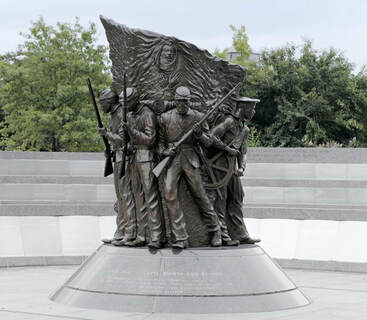 "The Spirit of Freedom" - Washington D.C. "The Spirit of Freedom" - Washington D.C. On May 22, 1863, the War Department issues General Order No. 143 establishing the “U.S. Colored Troops.” Then in short order: April 9, 1865, Robert E Lee surrenders; April 15, President Lincoln’s assassination; May 9, Civil War ends and finally June 19, slavery officially ends. Today, forty-five states celebrate “Juneteenth” or “Freedom Day” as a holiday yet it’s not recognized nationally. During this turbulent time, African-Americans sought safe places to fulfill their social, spiritual, educational and political needs. For most of the Napa African-American community, membership in the integrated Methodist Episcopal Church (ME) was one. Yet despite the anti-slavery congregation, cultural differences made it difficult for them to discuss politics and education. Edward Hatton’s Napa barbershop was another. He and his son Joseph were agents for both San Francisco African-American newspapers the Pacific Appeal founded 1862 and The Elevator founded 1865, vital components of their budding society. In April 1867, the newly formed African-American Methodist Episcopal (AME) Church of Napa purchases the old ME’s building with Aaron, Nathaniel, and five others as trustees. On October 2, they acquire property to house it. (Our first proof that Nathaniel reunited with his family.) Aaron’s father Robert, without any formal training, often officiated while Nathaniel ran the Sunday school. Since public schools didn’t exist until late 1870’s, the AME Church became Napa’s only African-American school. 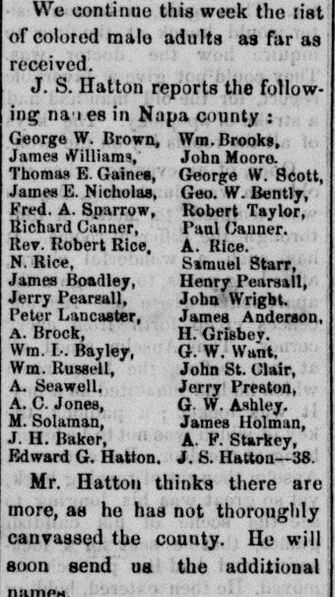 The Elevator November 26, 1869, Courtesy Public Domain The Elevator November 26, 1869, Courtesy Public Domain After three years of struggle, the 14th Amendment granting citizenship to African-Americans is ratified on July 9, 1868. However, without voter protections, full citizenship remained elusive. Thus on February 26, 1869, the 15th Amendment is drafted, securing voting rights for all citizens. To pressure the California Legislature for ratification, both The Elevator and Pacific Appeal sponsored preregistration efforts of African-Americans. The November 26, 1869, issue of The Elevator, publishes Joseph Hatton’s list of prospective voters naming Aaron, Nathaniel, his father Rev. Robert Rice, and 35 others. By February 3, 1870, the Amendment is ratified causing widespread celebration. (However, it takes the civil rights movement of the 50s and 60s for California to finally ratify the 14th Amendment in 1959 and the 15th Amendment in 1962.) Aaron registers for the first time on April 16, 1870 along with Robert and Nathaniel. Until their deaths, they never missed an opportunity to vote. 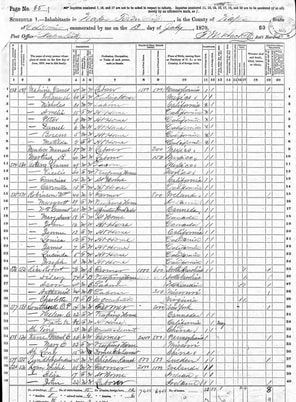 1870 US Census, Courtesy Public Domain 1870 US Census, Courtesy Public Domain The 1870 Census depicts the Rice family living together in their newly built farmhouse with Robert 70 as head of household, Dilcy 74, Aaron 49, Charlotte 58, Nathaniel 24 with Robert owning the property valued at $1,000 ($20,000 today) and a personal of $600 ($12,000 today), while Nathaniel’s personal estate is $200 ($4,000 today). However, Aaron has no wealth recorded despite purchasing two thirds of the property from Robert for $1 in 1869. Additionally, Robert, Dilcy and Aaron’s recorded origin of birth is N Carolina, Charlotte’s Virginia, Nathaniel’s Missouri, and Robert’s parents as foreign-born (Africa). It also recorded Aaron and Charlotte as illiterate, Robert and Dilcy as readers only, and Nathaniel as literate. 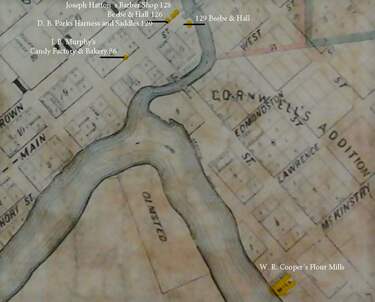 1869 Napa Map, Courtesy Public Domain 1869 Napa Map, Courtesy Public Domain From the historical record, we can imagine a day in the life of Aaron’s Family. Aaron and Nathaniel did most of the wheat harvesting and preparation of its milling. On a good day, they would haul the grain by wagon, traveling the dirt roads back into town to leave it with the W. R. Cooper’s Flour Mill. They would continue on to Main Street probably stopping at J. B. Murphy’s Candy Factory and Bakery to satisfy their sweet tooth or checking on Charlotte or Dilcy’s baked goods before visiting friends, the Hatton’s at their barbershop. If they needed horse equipment or repairs, next door was Beebe & Hall. Along their journey, they might have observed the Amelia a 174-foot steamboat or the Napa Valley Railroad transporting passengers and goods to and from Napa. After enough time passed, they would return to the mill for their flour to sell it or keep it for Charlotte and Dilcy to bake more goods for the market or Sunday church socials. With Nathanial being of marrying age, it was only a matter of time…. Judie & Joseph Palmer are two of the founding members of the Martinez Cemetery Preservation Alliance and the Potter’s Field Project. Both have a passion for discovery, history, genealogy, anthropology and archaeology. For more info, please visit our website MartinezCemetery.org. To learn more regarding our sources and detail about Aaron’s life, type Aaron Rice in the Search Bar. Do you have a Potter’s Field story to tell? We welcome any pictures or information regarding the Alhambra Cemetery’s Potter’s Field. Please email us at [email protected] or call us at (925) 316-6069.
|
AuthorsJudie & Joseph Palmer are two of the founding members of the Martinez Cemetery Preservation Alliance (MCPA) and the Potter’s Field Project. Both have a passion for discovery, history, genealogy, anthropology and archaeology. Archives
October 2021
Categories |

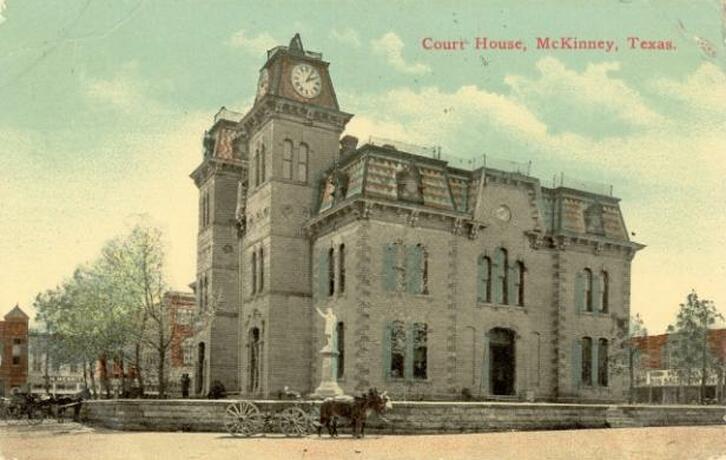
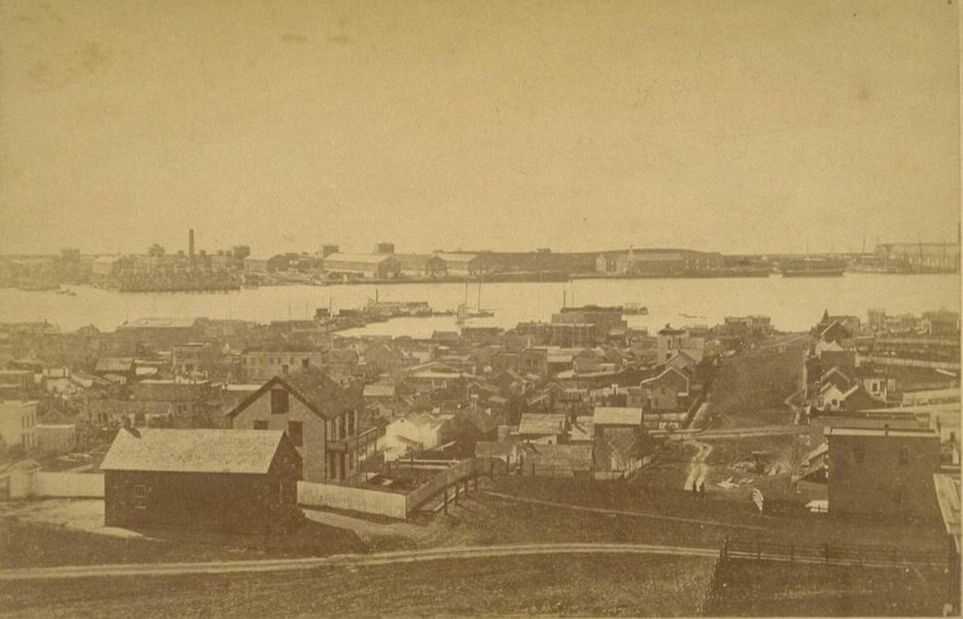
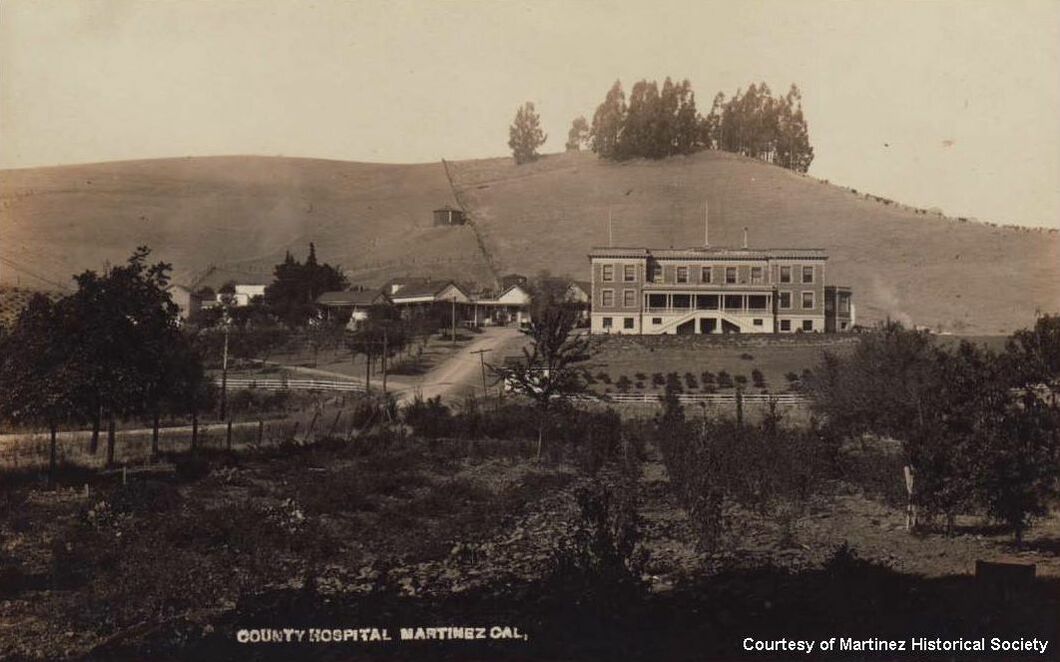
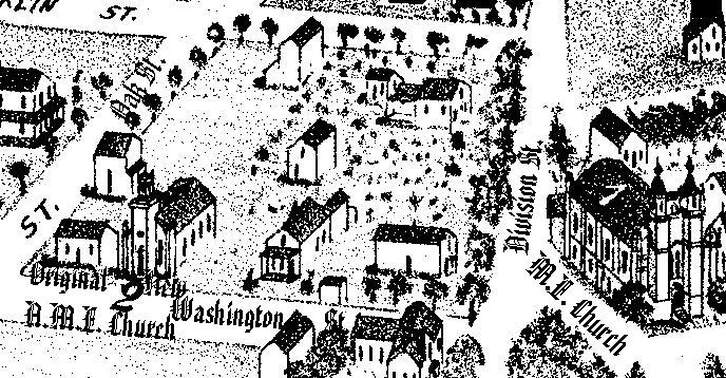
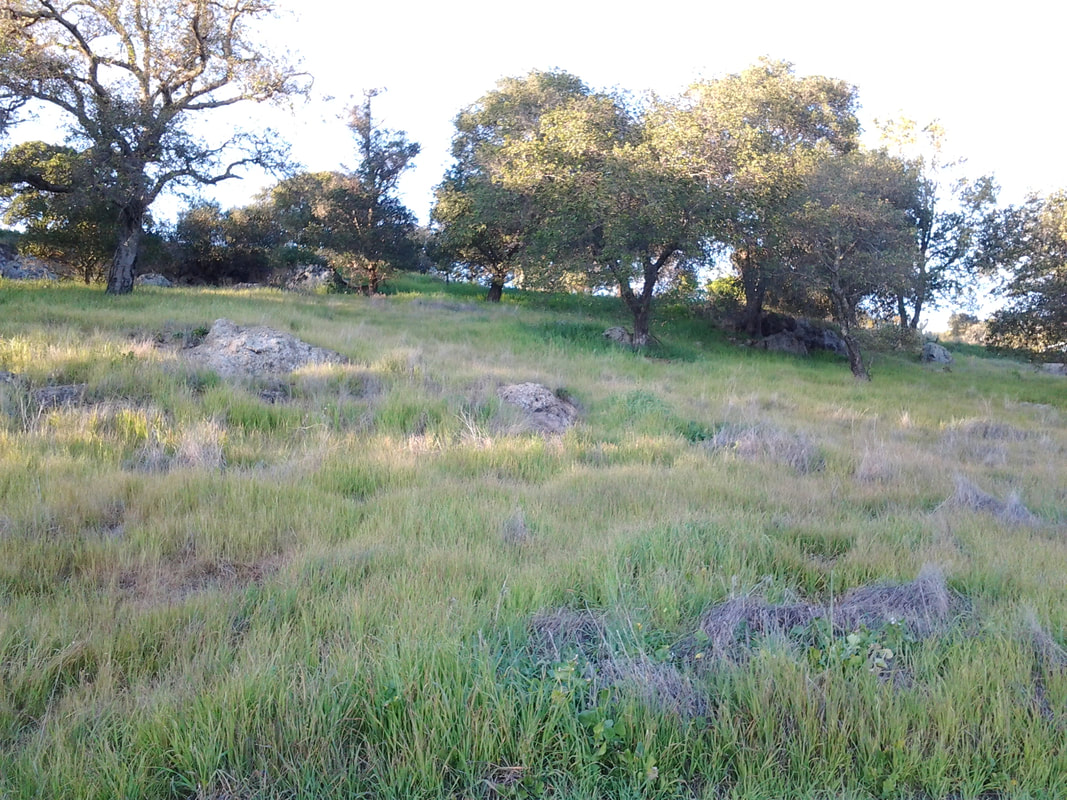


 RSS Feed
RSS Feed